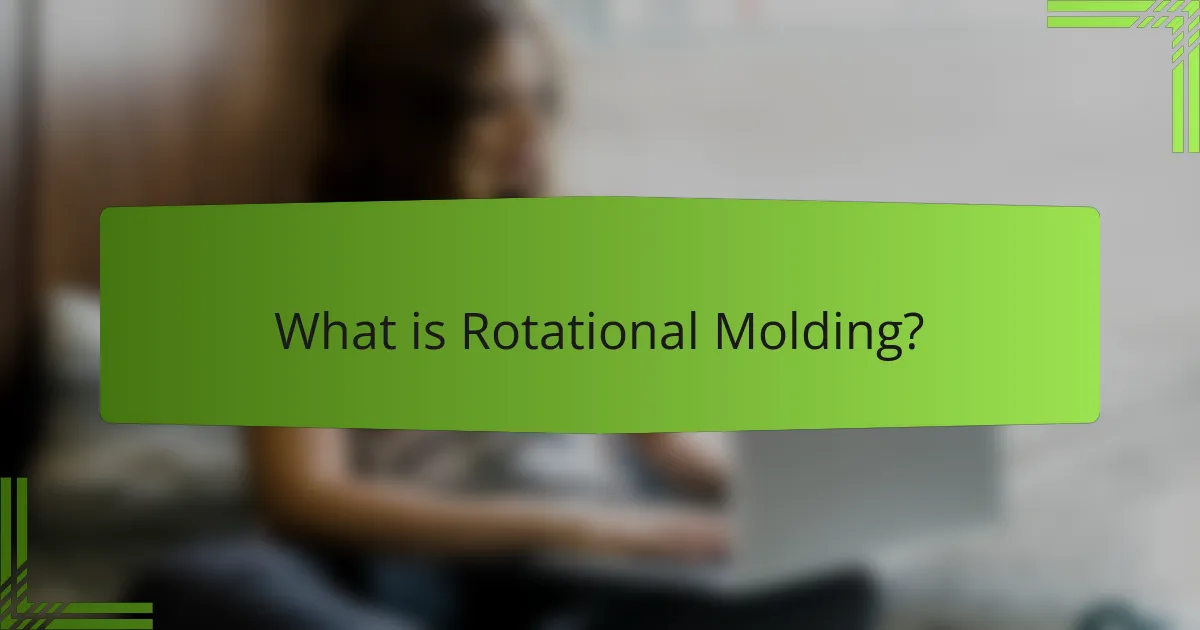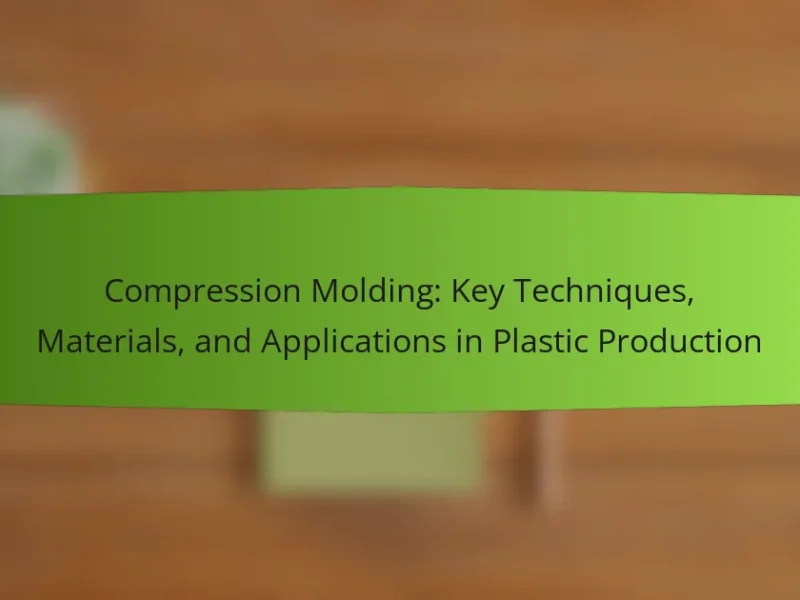Rotational molding is a manufacturing process that creates hollow plastic parts through heating plastic powder in a mold while rotating it around two perpendicular axes. This technique produces lightweight, durable products and is widely used for items such as tanks, containers, toys, and outdoor furniture. Key design considerations for rotational molding include wall thickness, part geometry, and material selection, which directly influence production efficiency and product performance. The versatility of this process allows for complex shapes and custom packaging solutions, making it suitable for various industries and production scales.

What is Rotational Molding?
Rotational molding is a manufacturing process used to create hollow plastic parts. It involves heating plastic powder in a mold while rotating it around two perpendicular axes. This rotation allows the plastic to evenly coat the interior surfaces of the mold. As the mold cools, the plastic solidifies, forming the final part. This process is known for producing lightweight and durable products. It is commonly used for items like tanks, containers, and playground equipment. The versatility of rotational molding allows for complex shapes and designs.
How does the rotational molding process work?
Rotational molding is a manufacturing process that creates hollow plastic parts. It involves loading powdered plastic material into a mold. The mold is then heated while being rotated on two perpendicular axes. This rotation allows the plastic to evenly coat the interior surfaces of the mold. As the mold continues to rotate, the plastic melts and fuses together. After sufficient heating, the mold is cooled to solidify the plastic. Finally, the mold is opened to release the finished product. This process is known for producing large, complex shapes with uniform wall thickness.
What are the key stages of the rotational molding process?
The key stages of the rotational molding process are loading, heating, cooling, and unloading. First, the mold is loaded with a specific amount of powdered resin. Next, the mold is heated while it rotates, allowing the resin to melt and coat the interior surfaces. After sufficient heating, the mold is cooled to solidify the resin. Finally, the mold is opened, and the finished product is unloaded. Each stage is crucial for achieving the desired shape and properties of the molded item.
What materials are commonly used in rotational molding?
Common materials used in rotational molding include polyethylene, polypropylene, and nylon. Polyethylene is the most widely used due to its excellent chemical resistance and durability. Polypropylene offers higher temperature resistance and is lightweight. Nylon is used for its strength and flexibility in specialized applications. Other materials like PVC and thermoplastic elastomers are also utilized but less frequently. These materials provide various properties suitable for different applications in rotational molding.
What are the advantages of using rotational molding?
Rotational molding offers several advantages. It allows for the production of complex shapes with uniform wall thickness. This process is cost-effective for low to medium production runs. It also enables the use of a wide range of materials, including various plastics. Rotational molding produces seamless parts, reducing the need for assembly. The process has low tooling costs compared to other methods like injection molding. Additionally, it provides excellent durability and resistance to impact. These benefits make rotational molding a preferred choice for many industries.
How does rotational molding compare to other manufacturing processes?
Rotational molding is a manufacturing process that produces hollow plastic parts. It differs from processes like injection molding and blow molding in several key ways. Rotational molding involves heating a plastic material in a mold and rotating it to evenly coat the interior. This results in a uniform thickness of the product. In contrast, injection molding injects molten plastic into a mold, which can lead to uneven thickness. Blow molding, on the other hand, uses air pressure to expand a plastic tube into a mold, which may not achieve the same design flexibility as rotational molding. Rotational molding is particularly advantageous for large, complex shapes and low to medium production runs. It also allows for the incorporation of various materials and colors easily. Overall, rotational molding is ideal for specific applications where design and material versatility are critical.
What are the cost benefits of rotational molding?
Rotational molding offers significant cost benefits due to its efficiency and material usage. The process minimizes waste by utilizing a hollow mold, allowing for near-complete material utilization. Production runs can be cost-effective, especially for large parts, as it requires less energy compared to other molding techniques. The tooling costs are lower since molds are typically less complex and easier to manufacture. Additionally, rotational molding allows for the production of large parts in a single cycle, reducing labor and time costs. This efficiency can lead to lower overall production costs, making it an attractive option for manufacturers.

What are the applications of rotational molding?
Rotational molding is used in various applications across multiple industries. Common applications include manufacturing large plastic parts like tanks and containers. It is also utilized for creating toys, automotive components, and outdoor furniture. The process is ideal for producing hollow parts with uniform wall thickness. Additionally, it is employed in creating custom packaging solutions. Rotational molding allows for intricate designs and color variations. Its versatility makes it suitable for both small and large production runs. Industries benefit from its cost-effectiveness and efficiency in producing durable products.
Which industries utilize rotational molding?
Rotational molding is utilized by several industries. Key industries include automotive, where it produces fuel tanks and interior components. The toy industry benefits from rotational molding for creating durable toys. It is also used in the furniture sector for making outdoor furniture. Additionally, the agricultural industry employs rotational molding for manufacturing storage tanks and equipment. The marine industry utilizes it for boat parts and accessories. Lastly, the packaging industry uses rotational molding for creating containers and bins. Each of these industries values the versatility and efficiency of rotational molding in producing various products.
What types of products are commonly manufactured using rotational molding?
Common products manufactured using rotational molding include storage tanks, playground equipment, and automotive parts. Rotational molding creates hollow, seamless shapes. It is ideal for large items like kayaks and containers. Other products include bins, trash cans, and outdoor furniture. This process allows for complex designs and durable materials. The versatility of rotational molding supports various industries. It is widely used due to its cost-effectiveness and efficiency.
How does rotational molding meet specific industry needs?
Rotational molding meets specific industry needs by providing cost-effective and versatile manufacturing solutions. This process allows for the creation of large, hollow parts with uniform wall thickness. Industries such as automotive, marine, and consumer goods benefit from the lightweight and durable products produced. Additionally, rotational molding supports complex shapes that are difficult to achieve with other methods. The process also enables the use of various materials, including polyethylene and nylon, catering to different application requirements. Furthermore, it allows for the incorporation of color and textures directly into the product, enhancing aesthetic appeal. Overall, rotational molding aligns with industry demands for efficiency, customization, and quality.
What are some innovative applications of rotational molding?
Innovative applications of rotational molding include producing complex shapes for various industries. This technique is used in manufacturing large storage tanks for chemicals and water. Rotational molding creates lightweight playground equipment, enhancing safety and durability. It is also applied in automotive parts, such as fuel tanks and interior components. Additionally, custom packaging solutions for fragile items are developed using this method. Rotational molding enables the design of unique art installations that are both functional and aesthetic. The process allows for the creation of insulated containers for temperature-sensitive products. These applications demonstrate the versatility and efficiency of rotational molding across different sectors.
How is rotational molding used in custom product design?
Rotational molding is used in custom product design to create complex shapes and large hollow parts. This manufacturing process involves heating a plastic material in a mold while rotating it along two axes. The rotation ensures even distribution of the material, allowing it to coat the interior surfaces of the mold. This technique is particularly effective for producing items like storage tanks, playground equipment, and automotive parts.
Rotational molding allows for design flexibility, enabling the creation of intricate details and varying wall thicknesses. It can accommodate a wide range of materials, including polyethylene and nylon, which enhances its versatility. The process also supports low production costs for small to medium-sized runs, making it ideal for custom designs.
Additionally, the finished products can exhibit excellent durability and resistance to impact and weathering. This durability is crucial for items used in outdoor applications. Overall, rotational molding is a valuable method in custom product design due to its ability to produce high-quality, tailored products efficiently.
What role does rotational molding play in sustainable manufacturing?
Rotational molding plays a significant role in sustainable manufacturing by minimizing material waste. This process allows for the efficient use of polymers, as it produces hollow parts with uniform wall thickness. The method requires less energy compared to other molding techniques, reducing the overall carbon footprint. Additionally, rotational molding can utilize recycled materials, promoting circular economy practices. Studies show that using recycled plastics in rotational molding can decrease energy consumption by up to 30%. This aligns with sustainability goals by reducing reliance on virgin materials and lowering environmental impact.

What design considerations are important in rotational molding?
Key design considerations in rotational molding include wall thickness, part geometry, and material selection. Wall thickness must be uniform to avoid weak spots and ensure even heat distribution. Part geometry affects the ease of mold release and the overall strength of the final product. Complex shapes may require additional design features like ribs or supports to enhance structural integrity. Material selection is critical, as different polymers offer varying properties such as flexibility, strength, and resistance to environmental factors. Additionally, draft angles should be incorporated to facilitate easy removal from molds. These considerations directly impact production efficiency and product performance.
What factors influence the design of rotational molded products?
The design of rotational molded products is influenced by several key factors. These factors include material selection, wall thickness, part geometry, and production volume. Material selection determines the physical properties and durability of the final product. Common materials used in rotational molding include polyethylene and nylon, each offering specific benefits. Wall thickness affects the strength and weight of the product. Designers must balance durability with material cost and weight considerations. Part geometry influences the ease of manufacturing and the final appearance of the product. Complex shapes may require more design adjustments. Production volume impacts the choice of design features. Higher volumes may justify more intricate designs, while lower volumes may favor simpler, cost-effective solutions.
How do wall thickness and part geometry affect product performance?
Wall thickness and part geometry significantly influence product performance in rotational molding. Thicker walls generally enhance strength and durability. However, they can also increase weight and material costs. Conversely, thinner walls reduce weight and material use but may compromise structural integrity.
Part geometry affects stress distribution during use. Complex shapes can lead to uneven wall thickness, resulting in weak points. These weak points can cause failure under stress. Additionally, geometry impacts heat transfer during the molding process. Efficient heat transfer is crucial for uniform cooling and avoiding defects.
Research indicates that optimal wall thickness varies based on application requirements. For example, a study by the Society of Plastics Engineers shows that a wall thickness of 3-5 mm is ideal for many applications. This balance maximizes strength while minimizing material use.
What design features can enhance the functionality of molded parts?
Design features that enhance the functionality of molded parts include wall thickness variation, ribbing, and integrated features. Wall thickness variation allows for optimized strength and weight distribution. Ribbing increases structural integrity without adding excessive weight. Integrated features, such as hinges or snap-fits, reduce assembly time and improve part performance. These design elements contribute to better material flow during molding, ensuring even distribution and minimizing defects. Properly implemented design features can lead to cost savings in production and enhanced product durability.
What are the common challenges in designing for rotational molding?
Common challenges in designing for rotational molding include material selection, wall thickness uniformity, and part complexity. Material selection is crucial as it affects the final product’s strength and durability. Achieving uniform wall thickness is essential to prevent warping and ensure even cooling. Part complexity can lead to difficulties in mold design and increased production costs. Additionally, achieving proper draft angles is necessary for easy part removal from molds. Designing for shrinkage is also critical, as materials can contract during cooling. These challenges require careful consideration to optimize the design process and ensure successful production.
How can designers mitigate issues related to shrinkage and warping?
Designers can mitigate issues related to shrinkage and warping by optimizing material selection and design geometry. Choosing materials with low shrinkage rates can significantly reduce these issues. Additionally, incorporating uniform wall thickness in designs helps maintain consistent cooling rates. Implementing proper cooling techniques during the molding process also minimizes temperature variations. Using mold materials that have good thermal conductivity aids in even heat distribution. Furthermore, careful control of processing parameters, such as temperature and pressure, can enhance dimensional stability. Research indicates that these strategies effectively reduce defects associated with shrinkage and warping in rotational molding applications.
What best practices should be followed in the design phase?
In the design phase of rotational molding, it is essential to prioritize functionality and manufacturability. Designers should ensure that the part geometry allows for uniform wall thickness to avoid weak spots. Incorporating draft angles facilitates easy part removal from molds. Selecting appropriate materials based on the application is crucial for performance and durability. Additionally, considering shrinkage rates during the design helps in achieving precise dimensions. Prototyping and testing designs can identify potential issues early in the process. Collaborating with manufacturers during the design phase can optimize production efficiency. Adhering to these best practices enhances the overall quality and effectiveness of the final product.
What tips can help optimize the rotational molding process?
To optimize the rotational molding process, ensure proper temperature control throughout the cycle. Consistent heating prevents uneven wall thickness. Additionally, select appropriate materials that suit the design requirements. Using high-quality resins improves product durability. Optimize cycle times to enhance production efficiency. Shorter cycles can reduce costs while maintaining quality. Implement thorough mold design with adequate venting to prevent air traps. Proper venting enhances material flow and reduces defects. Regular maintenance of equipment also ensures reliable operation and consistent output. These practices collectively lead to improved efficiency and product quality in rotational molding.
Rotational molding is a manufacturing process that creates hollow plastic parts by heating plastic powder in a mold while rotating it around two axes. This article provides an overview of the rotational molding process, including its stages, advantages, and common materials used. Additionally, it explores the applications of rotational molding across various industries, design considerations, and innovative uses, highlighting its cost-effectiveness and efficiency. Key factors influencing product design and best practices for optimizing the molding process are also discussed, emphasizing the importance of uniform wall thickness and material selection.


